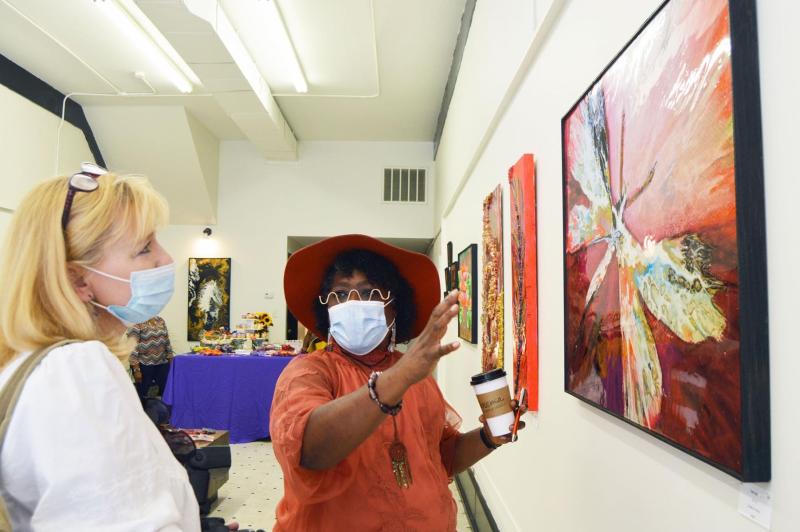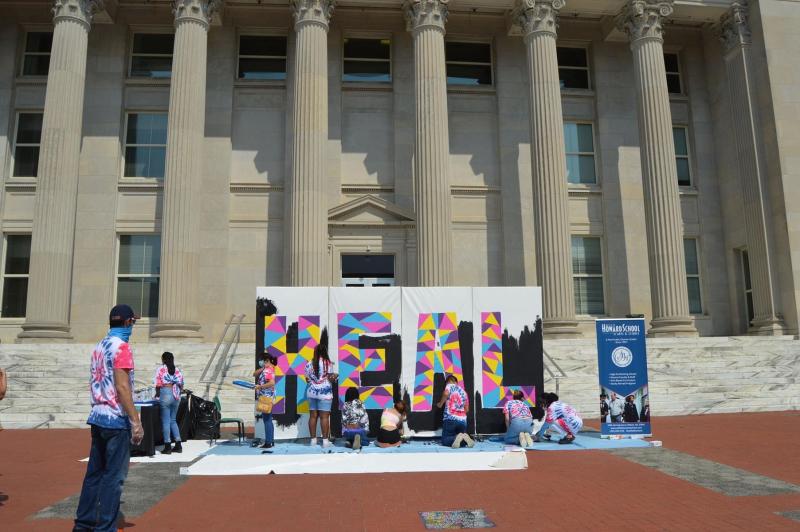ARP Grant Spotlight: Wilson Arts

ArtSpin is a collaborative community event featuring the arts in Wilson County. Local artist Andrea Horton-Morton discusses the artwork she created during her recent journey with cancer to visitors of the Eyes on Main Street Galleries. Photo courtesy of Wilson Arts
Wilson is a small city in North Carolina that was once known as the World’s Greatest Tobacco Market, but has recently found itself home to something different: a developing local arts scene. Part of this development is thanks to Wilson Arts, the city’s local arts agency that has grown from its origin 54 years ago as a coalition of civic-minded citizens into a leading arts organization in the community.
The resiliency of local arts communities across the country was put to the test during the coronavirus pandemic, with arts venues among the first to close and last to reopen. Wilson Arts was no exception to this uncertainty, but a recent $150,000 American Rescue Plan (ARP) grant from the National Endowment for the Arts will empower the agency to revitalize the arts in Wilson.
The ARP grant will be a significant investment in the Wilson arts community because it allows recipients the opportunity to subgrant to individual artists and other arts organizations. Previous NEA grants have helped the arts excel in Wilson, including the Eyes on Main Street Photography Festival and support for the Vollis Simpson Whirligig Park through the NEA Our Town creative placemaking initiative. These investments have helped the creative community continue to grow, which in turn helps the entire Wilson community flourish.
As part of its commitment to the arts community and to meet the eligibility requirements of the NEA’s ARP grant application, Wilson Arts undertook the rigorous process of being officially designated as a local arts agency (LAA). This meant advocating for resolutions to be passed at both the city and county levels of government. Executive Director Cathy Hardison said the process taught her about collaboration and coordination, and that at the end it was rewarding to have grant funding to show the effort was worth it.
Wilson Arts’ designation as an LAA is not the first major change the organization has undergone during the COVID-19 pandemic. In August 2020, the organization changed its name from the Arts Council of Wilson to Wilson Arts. Hardison feels the new name and logo reinforce the core beliefs that the arts are for everyone and that they bring people together and strengthen communities.
Hardison grew up in Wilson and has seen the vital role the arts play in the community and her own life. “I recognize that a sense of place is so important, which is why during the pandemic we did everything we could to continue holding our programming and events in safe, conscious ways—so people could still be together and experience art,” she said.

ArtSpin is a collaborative community event featuring the arts in Wilson County. Sallie B. Howard School of the Arts students create a public art mural in front of the Wilson County Courthouse. Photo courtesy of Wilson Arts
As part of its commitment to supporting the local arts community during the ongoing pandemic, Wilson Arts has become even more of a resource for the recent surge of artist studios, galleries, and performing arts groups that have opened in Wilson over the past five years. Wilson Arts’ efforts included keeping the arts community informed of available relief opportunities, encouraging the completion of surveys documenting impact, advocating for reaching out to legislators, pivoting programs to keep artists working and employed, and distributing $145,000 in Coronavirus Aid, Relief, and Economic Security Act (CARES) funding from the North Carolina Arts Council (CARES funding was distributed by the NEA to state arts agencies in 2020) . Thanks to CARES Act funding and partnerships, the local arts community has remained resilient—banding together to host programming and events that are accessible to all.
“The role of Wilson Arts has shifted to being more of an umbrella organization, and in taking on this leadership role it will be transformative for individual artists and their community partnerships,” Hardison said.
The organization manages two facilities for a total of more than 30,000 square feet of event space, The Wilson Arts Center and the Edna Boykin Cultural Center. The Wilson Arts Center recently underwent a major renovation and re-opened to the public in May of 2021, but throughout the pandemic the Boykin Cultural Center was the host of many socially distanced events, including summer camps, art classes, and other gallery exhibitions as well as a host of online events.
Hardison said one of the most difficult programs to put on during the pandemic was the youth theater productions. ACT! For Youth, the live theater opportunity for children in kindergarten through high school, adopted smaller budget productions and secured streaming licensing to air shows online instead of in a large theater. Through these modifications, Wilson youth were able to remain involved and engaged in the theater. Hardison is hopeful that the new ARP funding will help keep programs like this going, and that the arts can continue to build Wilson into a thriving, vibrant community.
“I’m so proud of our community’s resiliency and the way we have dismantled and reconstructed events to keep people involved and present,” she said. “It’s been very special to be a part of. Making it through the pandemic has taken a village, and through it all we have a lot to celebrate.”




